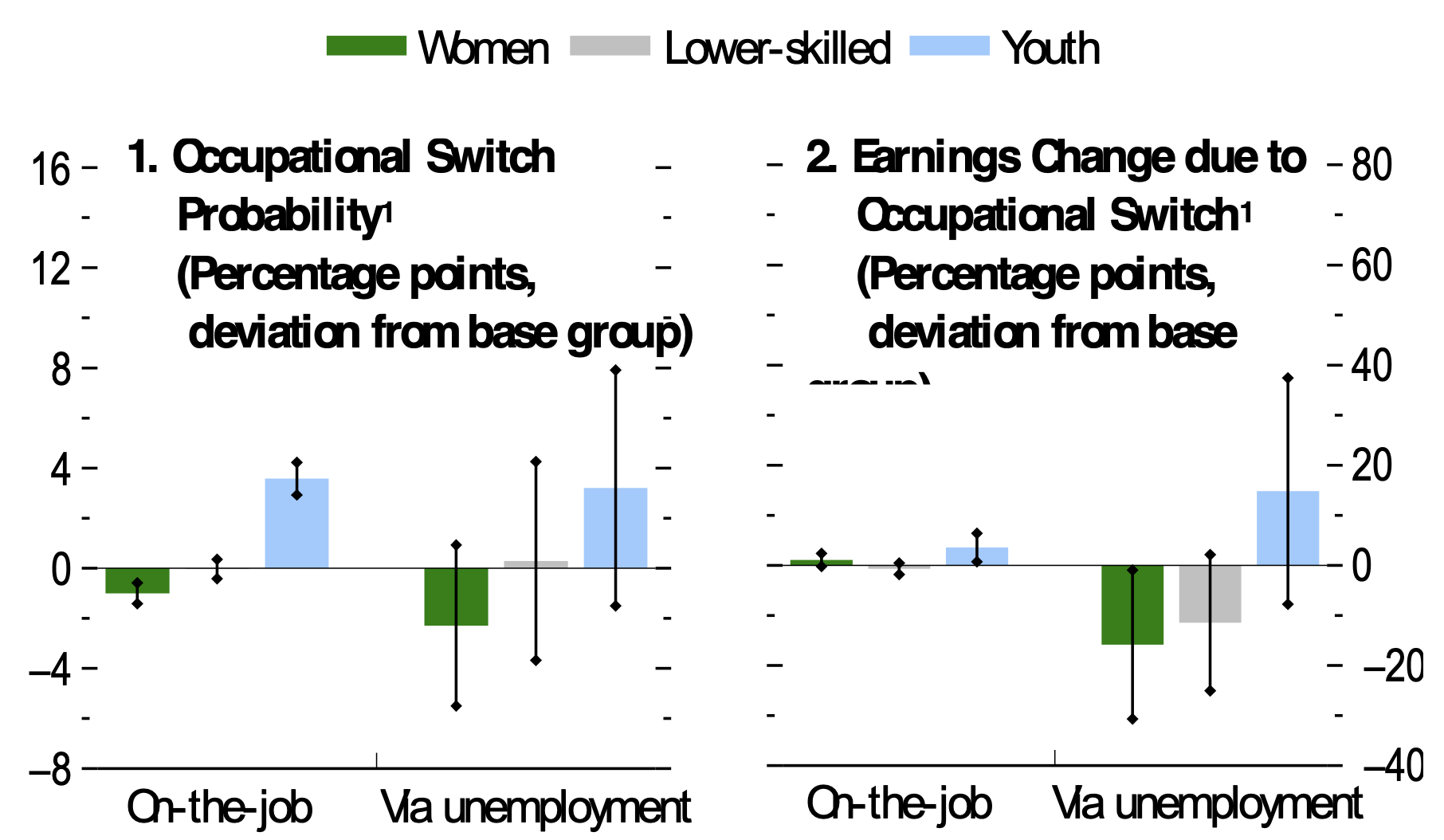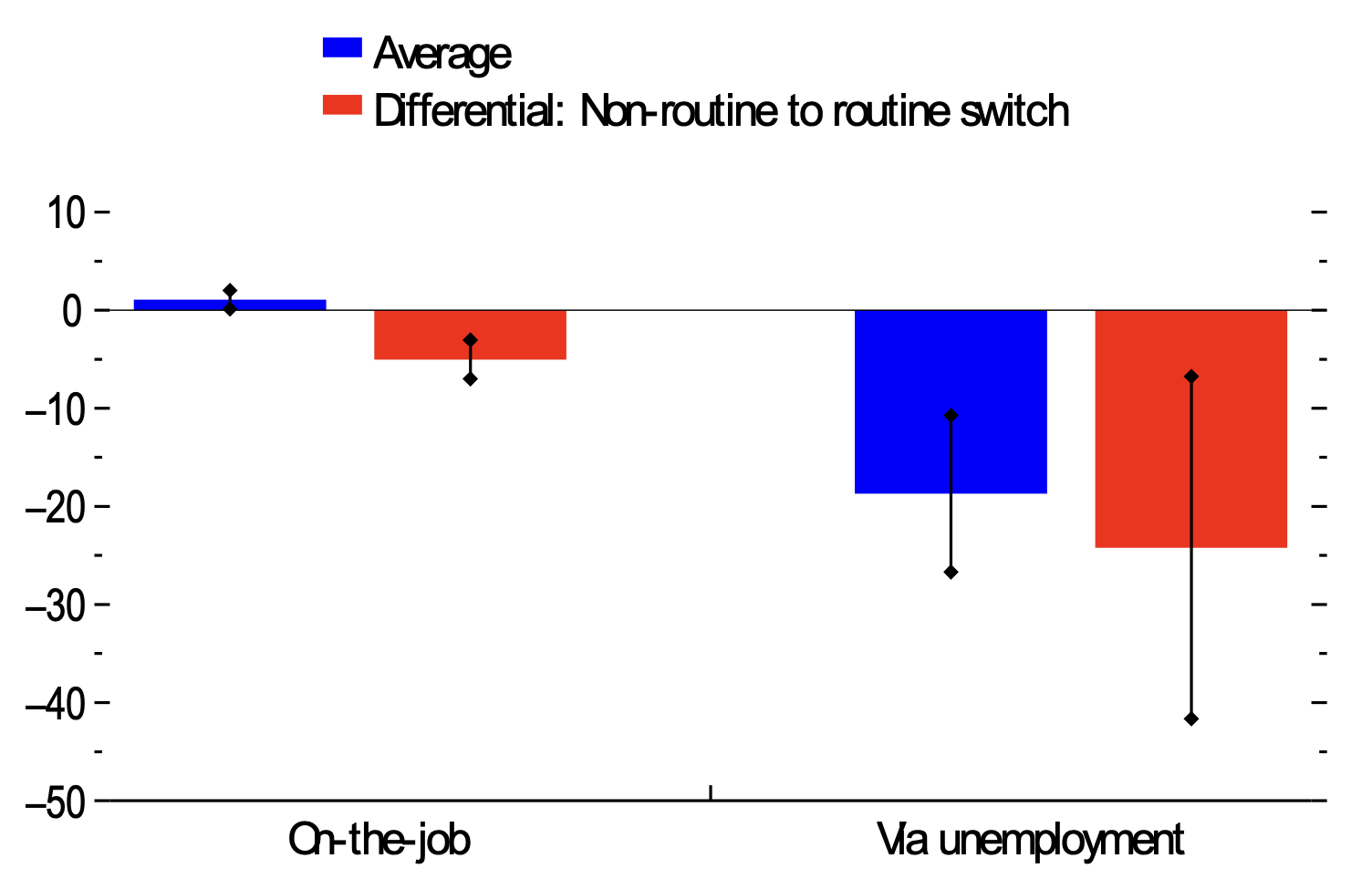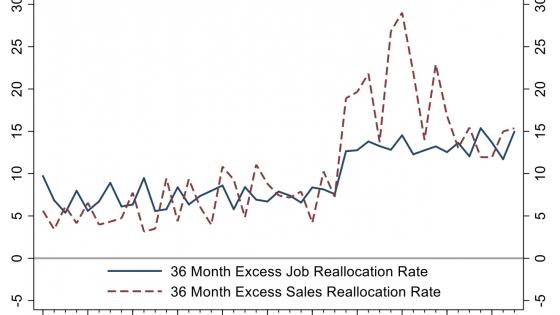The ability of workers to readily switch occupations or sectors of employment during their careers is often put forward as critical for the economy’s dynamism and adaptability, and the COVID-19 recession and recovery has accentuated the importance of reallocation (Abendschein et al. 2022, Anay et al. 2021, Carrillo-Tudela et al. 2022). However, little is known about how sectoral or occupational switches affect workers’ earnings. Most existing studies focus on US labour market dynamics (Kambourov and Manovskii 2008), or consider only a selected, few advanced economies (Carrillo-Tudela et al. 2016, Hemit et al. 2022). In a new paper (Bluedorn et al. 2022), we set out to investigate this question and explore how earnings after job changes vary with worker and job characteristics.
We study the question using extensive micro data across 30 European countries. Specifically, we evaluate the impact of workers’ sectoral and occupational changes and their earnings’ consequences, conditional on worker characteristics (educational attainment, gender, and age), job features (routinisability), and the business cycle. To do so, we combine two different data sets – the European Union Labour Force Survey (EU-LFS) and the European Union Statistics on Income and Living Conditions (EU-SILC). Our paper complements Bachmann et al. (2020), who also study occupational mobility in Europe using the EU-SILC data. Our main contributions to this existing paper are twofold. First, we explore the importance of ‘routinisability’ in occupational switches, which is crucial to understand long-term labour market trends. Second, we document the importance of the business cycle on workers’ sectoral and occupational mobility.
Younger workers appear to benefit more from reallocation
The gains from job changes depend upon how the change occurs as well as worker characteristics. Workers can either switch occupations while still employed (‘on-the-job’) or after an intermediate spell of unemployment (‘via unemployment’). This distinction is important: the average job-to-job occupational switch is associated with a gain of around 1.9%, while the average occupational switch via unemployment is associated with an earnings penalty of 15.8% (Figure 1, right panel). This large difference arises because a job-to-job occupational change is by choice, while an occupational change via unemployment is more likely forced by necessity. Importantly, these averages mask notable heterogeneity across demographic groups. Specifically, younger workers (age 15 to 29) on average receive larger earnings gains than other demographic groups when changing occupations via a job-to-job switch. On the other hand, younger workers face the same large earnings penalty when switching occupations following a spell in unemployment. In contrast, low-skilled workers (with non-tertiary and secondary education and below) do not see additional gains from occupational switches on average, regardless of whether the switches are on-the-job or via unemployment. Women suffer a larger earnings penalty than other demographic groups when switching occupations via an intermediate spell in unemployment.
Figure 1 Occupational switches
Sources: EU Statistics on Income and Living Conditions, and authors’ calculations.
Note: Occupational switches on-the-job are calculated from individuals who are employed in the current and previous year and switched occupations. Occupational switches via unemployment are calculated from individuals who are employed in the current year and were unemployed last year and switched occupations (based on their occupation of record two years before when last employed). Lower-skilled workers are those with non-tertiary and secondary education and below. Youth are those with ages between 15-29 years old. The whiskers indicate the 95% confidence band. 1Base group are prime-age and higher-skilled men.
Workers switching into routinisable jobs face a large earnings penalty. Our study also sheds light on how the growth of automation in jobs (routinisation) may impact earnings after an occupational switch. We find that workers switching into more routinisable occupations do not enjoy the usual earnings gains associated with a job-to-job switch (Figure 2). In fact, their earnings fall. Workers switching into more routinisable jobs via unemployment also suffer a higher earnings penalty than on average, particularly if they are low-skilled or older workers.
Figure 2 Earnings changes associated with routine jobs (percentage points, deviation from the base group)
Sources: EU Statistics on Income and Living Conditions, Integrated Public Use Microdata Series, Current Population Survey, and authors’ calculations.
Note: Occupational switches on-the-job are calculated from individuals who are employed in the current and previous year and switched occupations. Occupational switches via unemployment are calculated from individuals who are employed in the current year and were unemployed last year and switched occupations (based on their occupation of record two years before when last employed). The whiskers indicate the 95% confidence band. Differential: NonRoutine to Routine switch calculates the differential earnings changes relative to the rest of the workers.
Reallocation declines for younger workers during recessions
Given the large consequences for earnings, it is important to understand how reallocation varies over the business cycle. The impact of economic fluctuations on job prospects has been long debated by economists. Some view recessions as times when inefficiencies in the labour market are cleansed by accelerating the reallocation of workers toward more productive activities (e.g. Mortensen and Pissarides 1994, Groshen and Potter 2003, Jaimovich and Siu 2020). Examining the COVID-19 recession, Andrews et al. (2021) found that more productive firms were more likely to expand employment. Other researchers have found that employment-to-employment transitions are more frequent during expansions, suggesting a drop in voluntary reallocation during recessions (Barlevy 2002, Carrillo-Tudela et al. 2016).
Sectoral and occupational switch probabilities do not vary with the business cycle on average, but switches fall during recessions for younger workers. Although there is no statistically significant difference between job switch rates during expansions versus recessions, the probability of on-the-job job switches for younger workers does fall significantly during recessions. Because such reallocation tends to generate earnings gains for younger workers (as shown above), recessions are especially costly for youth.
The average gain in earnings associated with job-to-job changes also falls in recessions. The earnings gain associated with an on-the-job employment change is significantly reduced during a recession compared to during expansions. This could reflect the fact that during recessions, all job changes – whether on-the-job or via unemployment – are more likely to be done out of necessity, rather than to benefit from an improvement in earnings.
Our findings illustrate how the benefits of reallocation are unequally distributed across workers and jobs, and how recessions are especially costly for younger workers. Labour reallocation via on-the-job switches is generally associated with earnings gains, while workers reallocating through an intermediate spell in unemployment on average suffer an earnings loss. The earnings benefits from job-to-job changes are largest for younger workers, while workers shifting into routine occupations see earnings losses on average. Our findings also illustrate how the costs of recessions disproportionately affect younger workers’ prospects. First, job transitions tend to drop for youth during recessions, lowering the potential for occupational switches to climb up the earnings ladder. Moreover, even if a worker manages to switch occupations during a recession, the associated earnings gain is smaller on average. Taken together, these findings point to the need for policymakers to improve targeted support to younger workers for labour market reallocation in downturns. Moreover, similar to much earlier research, they reinforce the importance of education in helping to buffer workers’ earnings and employment against shocks.
Authors' note: The views expressed in this column are those of the authors and do not necessarily represent the views of the IMF, its Executive Board, or IMF management.
References
Andrews, D, A Charlton and A Moore (2021), “Covid-19 and the continued labour reallocation to productive and tech-savvy firms”, VoxEU.org, 22 September.
Abendschein M, O Causa and N Luu (2022), “Getting on the job ladder: The policy drivers of hiring transitions”, VoxEU.org, 2 May.
Anayi, L, J M Barrero, N Bloom, P Bunn, S Davis, J Leather, B Meyer, M Oikonomou, E Mihaylov, P Mizen and G Thwaites (2021), “Labour market reallocation in the wake of Covid-19”, VoxEU.org, 13 August.
Bachmann, R, P Bechara and C Vonnahme (2020), “Occupational Mobility in Europe: Extent, Determinants and Consequences”, De Economist 168 (1):79–108.
Bluedorn, J C, F Caselli, N J Hansen, I Shibata and M Mendes Tavares (2022), “The Distributional Impacts of Worker Reallocation: Evidence from Europe”, Working paper.
Barlevy, G (2002), “The sullying effect of recessions”, Review of Economic Studies 69(1): 65–96.
Carrillo-Tudela, C, B Hobijn, P She and L Visschers (2016), “The extent and cyclicality of career changes: Evidence for the UK”, European Economic Review 84: 18–41.
Carillo-Tudela, C, C Comunello, A Clymo, A Jäckle, L Visschers and D Zentler-Munro 2022, “Job search and mismatch during the Covid-19 pandemic”, VoxEU.org, 7 April.
Groshen, E L and S Potter (2003), “Has structural change contributed to a jobless recovery?”, Federal Reserve Bank of New York Current Issues in Economics and Finance 9(8): 1–7.
Hemit, C, C Malgouyres and P Brandily (2022), “Understanding the reallocation of displaced workers to firms”, VoxEU.org, 2 April,
Kambourov, G and I Manovskii (2008), “Rising Occupational and Industry Mobility in the United States: 1968–97”, International Economic Review 49: 41–79.
Jaimovich, N and H Siu (2020), “Job polarization and jobless recoveries”, Review of Economics and Statistics 102(1): 129–47.
Mortensen, D T and C A Pissarides (1994), “Job creation and job destruction in the theory of unemployment”, Review of Economic Studies 61(3): 397–415.










